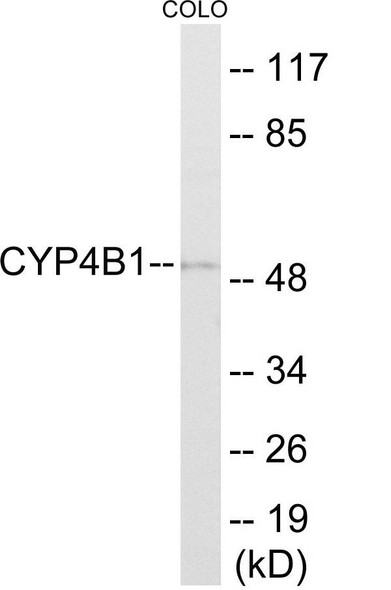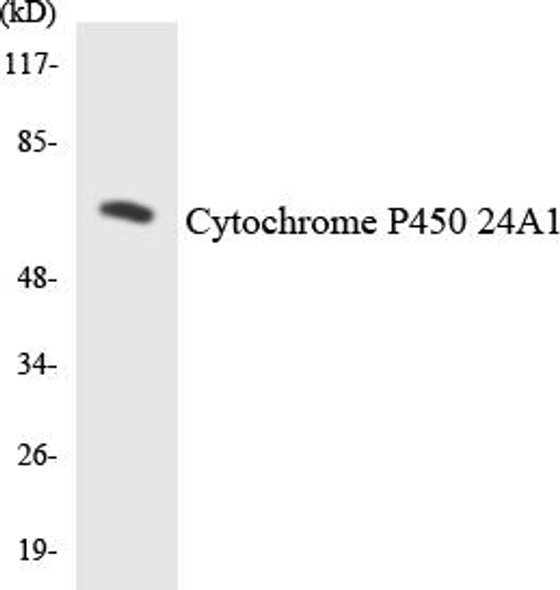Description
Cytochrome P450 2B6 Colorimetric Cell-Based ELISA
The Cytochrome P450 2B6 Colorimetric Cell-Based ELISA Kit is a cutting-edge tool designed for the precise measurement of cytochrome P450 2B6 levels in cell lysates and tissue samples. This kit offers exceptional sensitivity and specificity, ensuring accurate and consistent results for a variety of experimental settings.Cytochrome P450 2B6 is a key enzyme involved in drug metabolism, particularly in the liver, where it contributes to the breakdown of numerous medications. Variations in cytochrome P450 2B6 activity can impact drug efficacy and toxicity, making it a critical target for pharmacological research and personalized medicine approaches.
With its advanced technology and reliable performance, the Cytochrome P450 2B6 Colorimetric Cell-Based ELISA Kit is an indispensable tool for studying drug metabolism, understanding drug-drug interactions, and developing safer and more effective pharmaceutical treatments. Trust in this kit to deliver precise and valuable data for your research needs.
| Product Name: | Cytochrome P450 2B6 Colorimetric Cell-Based ELISA |
| Product Code: | CBCAB01190 |
| ELISA Type: | Cell-Based |
| Target: | Cytochrome P450 2B6 |
| Reactivity: | Human |
| Dynamic Range: | > 5000 Cells |
| Detection Method: | Colorimetric 450 nmStorage/Stability:4°C/6 Months |
| Format: | 96-Well Microplate |
The Cytochrome P450 2B6 Colorimetric Cell-Based ELISA Kit is a convenient, lysate-free, high throughput and sensitive assay kit that can detect Cytochrome P450 2B6 protein expression profile in cells. The kit can be used for measuring the relative amounts of Cytochrome P450 2B6 in cultured cells as well as screening for the effects that various treatments, inhibitors (ie siRNA or chemicals), or activators have on Cytochrome P450 2B6.
Qualitative determination of Cytochrome P450 2B6 concentration is achieved by an indirect ELISA format. In essence, Cytochrome P450 2B6 is captured by Cytochrome P450 2B6-specific primary antibodies while the HRP-conjugated secondary antibodies bind the Fc region of the primary antibody. Through this binding, the HRP enzyme conjugated to the secondary antibody can catalyze a colorimetric reaction upon substrate addition. Due to the qualitative nature of the Cell-Based ELISA, multiple normalization methods are needed:
| 1. | A monoclonal antibody specific for human GAPDH is included to serve as an internal positive control in normalizing the target absorbance values. |
| 2. | Following the colorimetric measurement of HRP activity via substrate addition, the Crystal Violet whole-cell staining method may be used to determine cell density. After staining, the results can be analysed by normalizing the absorbance values to cell amounts, by which the plating difference can be adjusted. |
| Database Information: | Gene ID: 1555, UniProt ID: P20813, OMIM: 123930, Unigene: Hs.1360 |
| Gene Symbol: | CYP2B6 |
| Sub Type: | None |
| UniProt Protein Function: | CYP2B6: cytochrome P450, subfamily IIB. Cytochromes P450 are a group of heme-thiolate monooxygenases. In liver microsomes, this enzyme is involved in an NADPH-dependent electron transport pathway. It oxidizes a variety of structurally unrelated compounds, including steroids, fatty acids, and xenobiotics. Phosphorylation is accompanied by a decrease in enzyme activity. |
| UniProt Protein Details: | Protein type:Oxidoreductase; Xenobiotic Metabolism - drug metabolism - cytochrome P450; Cofactor and Vitamin Metabolism - retinol; Xenobiotic Metabolism - metabolism by cytochrome P450; EC 1.14.14.1; Lipid Metabolism - arachidonic acid Chromosomal Location of Human Ortholog: 19q13.2 Cellular Component: endoplasmic reticulum membrane Molecular Function:arachidonic acid epoxygenase activity; heme binding; monooxygenase activity; oxygen binding; steroid hydroxylase activity Biological Process: drug metabolic process; epoxygenase P450 pathway; exogenous drug catabolic process; ketone metabolic process; steroid metabolic process; xenobiotic metabolic process Disease: Efavirenz, Poor Metabolism Of |
| NCBI Summary: | This gene, CYP2B6, encodes a member of the cytochrome P450 superfamily of enzymes. The cytochrome P450 proteins are monooxygenases which catalyze many reactions involved in drug metabolism and synthesis of cholesterol, steroids and other lipids. This protein localizes to the endoplasmic reticulum and its expression is induced by phenobarbital. The enzyme is known to metabolize some xenobiotics, such as the anti-cancer drugs cyclophosphamide and ifosphamide. Transcript variants for this gene have been described; however, it has not been resolved whether these transcripts are in fact produced by this gene or by a closely related pseudogene, CYP2B7. Both the gene and the pseudogene are located in the middle of a CYP2A pseudogene found in a large cluster of cytochrome P450 genes from the CYP2A, CYP2B and CYP2F subfamilies on chromosome 19q. [provided by RefSeq, Jul 2008] |
| UniProt Code: | P20813 |
| NCBI GenInfo Identifier: | 117205 |
| NCBI Gene ID: | 1555 |
| NCBI Accession: | P20813.1 |
| UniProt Secondary Accession: | P20813,Q2V565, Q9UK46, B4DWP3, |
| UniProt Related Accession: | P20813 |
| Molecular Weight: | 33,385 Da |
| NCBI Full Name: | Cytochrome P450 2B6 |
| NCBI Synonym Full Names: | cytochrome P450 family 2 subfamily B member 6 |
| NCBI Official Symbol: | CYP2B6 |
| NCBI Official Synonym Symbols: | CPB6; EFVM; IIB1; P450; CYP2B; CYP2B7; CYP2B7P; CYPIIB6 |
| NCBI Protein Information: | cytochrome P450 2B6 |
| UniProt Protein Name: | Cytochrome P450 2B6 |
| UniProt Synonym Protein Names: | 1,4-cineole 2-exo-monooxygenase; CYPIIB6; Cytochrome P450 IIB1 |
| Protein Family: | Cytochrome |
| UniProt Gene Name: | CYP2B6 |
| UniProt Entry Name: | CP2B6_HUMAN |
| Component | Quantity |
| 96-Well Cell Culture Clear-Bottom Microplate | 2 plates |
| 10X TBS | 24 mL |
| Quenching Buffer | 24 mL |
| Blocking Buffer | 50 mL |
| 15X Wash Buffer | 50 mL |
| Primary Antibody Diluent | 12 mL |
| 100x Anti-Phospho Target Antibody | 60 µL |
| 100x Anti-Target Antibody | 60 µL |
| Anti-GAPDH Antibody | 60 µL |
| HRP-Conjugated Anti-Rabbit IgG Antibody | 12 mL |
| HRP-Conjugated Anti-Mouse IgG Antibody | 12 mL |
| SDS Solution | 12 mL |
| Stop Solution | 24 mL |
| Ready-to-Use Substrate | 12 mL |
| Crystal Violet Solution | 12 mL |
| Adhesive Plate Seals | 2 seals |
The following materials and/or equipment are NOT provided in this kit but are necessary to successfully conduct the experiment:
- Microplate reader able to measure absorbance at 450 nm and/or 595 nm for Crystal Violet Cell Staining (Optional)
- Micropipettes with capability of measuring volumes ranging from 1 µL to 1 ml
- 37% formaldehyde (Sigma Cat# F-8775) or formaldehyde from other sources
- Squirt bottle, manifold dispenser, multichannel pipette reservoir or automated microplate washer
- Graph paper or computer software capable of generating or displaying logarithmic functions
- Absorbent papers or vacuum aspirator
- Test tubes or microfuge tubes capable of storing ≥1 ml
- Poly-L-Lysine (Sigma Cat# P4832 for suspension cells)
- Orbital shaker (optional)
- Deionized or sterile water
*Note: Protocols are specific to each batch/lot. For the correct instructions please follow the protocol included in your kit.
| Step | Procedure |
| 1. | Seed 200 µL of 20,000 adherent cells in culture medium in each well of a 96-well plate. The plates included in the kit are sterile and treated for cell culture. For suspension cells and loosely attached cells, coat the plates with 100 µL of 10 µg/ml Poly-L-Lysine (not included) to each well of a 96-well plate for 30 minutes at 37°C prior to adding cells. |
| 2. | Incubate the cells for overnight at 37°C, 5% CO2. |
| 3. | Treat the cells as desired. |
| 4. | Remove the cell culture medium and rinse with 200 µL of 1x TBS, twice. |
| 5. | Fix the cells by incubating with 100 µL of Fixing Solution for 20 minutes at room temperature. The 4% formaldehyde is used for adherent cells and 8% formaldehyde is used for suspension cells and loosely attached cells. |
| 6. | Remove the Fixing Solution and wash the plate 3 times with 200 µL 1x Wash Buffer for five minutes each time with gentle shaking on the orbital shaker. The plate can be stored at 4°C for a week. |
| 7. | Add 100 µL of Quenching Buffer and incubate for 20 minutes at room temperature. |
| 8. | Wash the plate 3 times with 1x Wash Buffer for 5 minutes each time. |
| 9. | Add 200 µL of Blocking Buffer and incubate for 1 hour at room temperature. |
| 10. | Wash 3 times with 200 µL of 1x Wash Buffer for 5 minutes each time. |
| 11. | Add 50 µL of 1x primary antibodies (Anti-Cytochrome P450 2B6 Antibody and/or Anti-GAPDH Antibody) to the corresponding wells, cover with Parafilm and incubate for 16 hours (overnight) at 4°C. If the target expression is known to be high, incubate for 2 hours at room temperature. |
| 12. | Wash 3 times with 200 µL of 1x Wash Buffer for 5 minutes each time. |
| 13. | Add 50 µL of 1x secondary antibodies (HRP-Conjugated AntiRabbit IgG Antibody or HRP-Conjugated Anti-Mouse IgG Antibody) to corresponding wells and incubate for 1.5 hours at room temperature. |
| 14. | Wash 3 times with 200 µL of 1x Wash Buffer for 5 minutes each time. |
| 15. | Add 50 µL of Ready-to-Use Substrate to each well and incubate for 30 minutes at room temperature in the dark. |
| 16. | Add 50 µL of Stop Solution to each well and read OD at 450 nm immediately using the microplate reader. |
(Additional Crystal Violet staining may be performed if desired – details of this may be found in the kit technical manual.)






